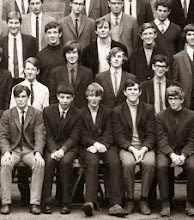
I should have included this handy book in the last post: Intercity 225 Leeds to London; a Traveller's Book, by Maureen Ellis and published by Hawksheath Press, Shadwell, Leeds in 1993. The trouble is, I always mean to take it with me on the train down South and I always forget. Even the combined brains of myself and Penny failed last week. Still, I enjoy reading it at home - loads of good stuff such as a reminder to look out for Potteric Carr nature reserve near Doncaster, and the revelation that the bitterns which formerly lived there were known locally as Butterbumps.
 Meanwhile, here's a coincidence. Two books of the type I greatly like and consider extremely virtuous because of the role models they present to today's young. Way back at the start of the blog, I commended James Thompson's Leeds Born and Bred. Well here's Bradford's equivalent and, sort-of, Sheffield's. But what is this? Isn't that the same attractive young woman on the covers of both Bradford's Own by Derek A J Lister, Sutton Publishing 2004, and The Unseen, the Unsightly and the Amusing in Sheffield by J Edward Vickers, Hallamshire Press 1997? It is.
Meanwhile, here's a coincidence. Two books of the type I greatly like and consider extremely virtuous because of the role models they present to today's young. Way back at the start of the blog, I commended James Thompson's Leeds Born and Bred. Well here's Bradford's equivalent and, sort-of, Sheffield's. But what is this? Isn't that the same attractive young woman on the covers of both Bradford's Own by Derek A J Lister, Sutton Publishing 2004, and The Unseen, the Unsightly and the Amusing in Sheffield by J Edward Vickers, Hallamshire Press 1997? It is. Music hall afficionados will recognise Gertie Millar, and the honour of producing her is very definitely Bradford's. I used to live in Southfield Square, Manningham, a stone's throw from the cul-de-sac where she was born. She is only in The Sheffield book because she played the theatres there. Tush. Still, a pretty face on the cover sells books (and newspapers).
Music hall afficionados will recognise Gertie Millar, and the honour of producing her is very definitely Bradford's. I used to live in Southfield Square, Manningham, a stone's throw from the cul-de-sac where she was born. She is only in The Sheffield book because she played the theatres there. Tush. Still, a pretty face on the cover sells books (and newspapers).

SNAP!
These books are about famous people (and events, including the atomic experiment at Sheffield Uni in 1924 which prompted hundreds of letters in advance begging the scientists to desist, in case they destroyed the world - tee-hee, but maybe prescient).
 Here are two more I have used about those who left less of a memorial, but thanks to A Photographic Memory by Jack Hulme, Yorkshire Arts Circus 1986, and They Worked All Their Lives by Carl Chinn, Manchester University Press 1988, are not forgotten.
Here are two more I have used about those who left less of a memorial, but thanks to A Photographic Memory by Jack Hulme, Yorkshire Arts Circus 1986, and They Worked All Their Lives by Carl Chinn, Manchester University Press 1988, are not forgotten.  The second of the two is particularly useful, as its first-hand data shows how urban grime and misery in the 19th century was every bit as grim in London, Brum and other such places as it was in the industrial North.
The second of the two is particularly useful, as its first-hand data shows how urban grime and misery in the 19th century was every bit as grim in London, Brum and other such places as it was in the industrial North.

No comments:
Post a Comment